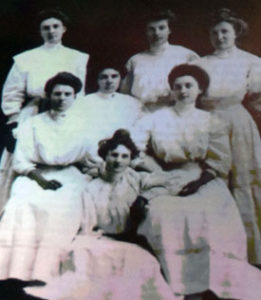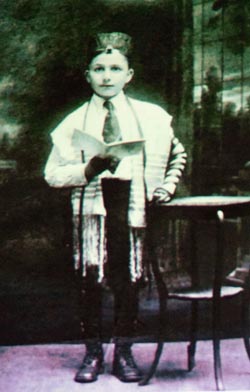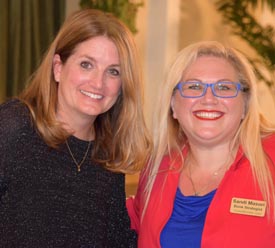By Donald H. Harrison


SAN DIEGO – Have you ever wanted to write a memoir or a family history, but simply had no idea how to go about it? It’s easier than you think, according to a panel of women who addressed La Playa Trail Association members on Tuesday night at the Point Loma Assembly.
Colleen O’Connor, a retired history professor, anchored the presentations, telling how a photograph that used to hang in her mother’s dining room launched her on a process that led to a $250,000 grant from the National Endowment for the Humanities to encourage people to take out their old photos and relate the stories that they have to tell.
Only a week before her mother died, O’Connor’s mother identified the photo showing eight well-dressed women as O’Connor’s grandmother and her seven sisters, who were not the aristocrats that they appear to be in the photo, but rather were homesteaders in North Dakota, who owned homes in their own names. “My grandmother, in the back center [of the photograph] was a suffragette,” O’Connor related. “They rode horses; they shot their dinners. They were what you would call today ‘liberated women.’”
Researching the photograph made O’Connor “realize that a photograph can drive history.” She suggested to the membership of La Playa Trail Association that “every person has a photograph, every photograph has a story, and that story is history that needs to be preserved.”
“If you don’t save it, nobody will,” she added. “They (descendants) don’t want your silver, but they do want your history and their history.”
The O’Connor family has been active in San Diego. Colleen’s sister Maureen was a mayor of San Diego. Colleen at one point ran for Congress unsuccessfully. After Colleen’s encounter with the photo of her grandmother and great aunts, “I started to teach using photographs, and then we started using photographs in exhibitions, and it became a bigger and bigger project.

“We literally collected thousand of photographs from all over San Diego County. We did exhibitions at the San Diego Historical Society as it was called then. We were at the courthouses in Chula Vista and East County. We did them on the Star of India on millennial night and projected photographs on the sail.”
There was “no place we couldn’t show these things, and they always generated more photographs,” said O’Connor. The San Diego Union published each week a photograph with a story about that person’s family who lives in San Diego. It was sensational.” A good portion of the work was published in the book, Faces of San Diego.”
Photographer Claire Wachowiak, who has published books of photography, including one about Morocco, said “I believe every picture tells a story; every family has a photo; and every photo tells a story.” To start putting together a family book of photography, she suggested, “go with one of your favorites. … Maybe just write a caption. Don’t get hung up on dates but ask family members what happened.”
She suggested that when examining family photos, helpful questions to ask are “Where the photo was taken?”; “How did they get here?”; and “How did they spend their time?”
She showed a photo that had been taken in 1888 that was yellowing with age and becoming less distinct. Then she showed the same photo that her company, clairemariephotos@gmail.com, had restored, making it ready for republication as a book, or perhaps framed as a present.

The final speaker was my daughter, Sandi Masori, whose company helps authors self-publish books by sub-contracting for editors, proofreaders, lay-out artists, cover designers, formatters, illustrators, and marketers who run best-seller drives on Amazon. Having helped more than 100 authors publish their non-fiction books, some being memoirs, others being business expertise books, Masori said there are several reasons why people, especially when they are older, might want to write a memoir.
“One reason is to leave a legacy, so that they have something out there for posterity, for their children, their grandchildren, and their great-grandchildren,” said Masori, who also writes the “Noshing with Sandi” restaurant review column for San Diego Jewish World. “The things that have happened to you, maybe when your kids were teenagers they weren’t interested in. But, as they grow, they really want to know: ‘Who are my family members; where did they come from, what are their stories?’ I think your future generations would like to know you as a person, and not just a figure.”
Masori said another reason people write memoirs is to “magnify a message.”
“Maybe you went through something in your life, or survived something, and you want to share that inspiration with everyone. You want to help other people get through it. Maybe it is surviving breast cancer, or a difficult divorce, or domestic abuse. Or, maybe it was something amazing, phenomenal: you were the first woman or man who did something, and have an incredible story.”
On the professional side, she added, sometimes people want to make celebrities of themselves, or demonstrate their expertise. There is something that happens when you publish a book, and you hand it to someone,” she said. “They kind of look at you differently: ‘Oh, wow, now I’ve got to take you seriously, you are an author.’”
She said many people want to write a book, but less than 2 percent of the people do. One reason for not following through with that desire, she added, is people feel that they don’t have sufficient time, or feel overwhelmed by the process, or don’t know where to start.
Masori reiterated O’Connor’s and Wachowiak’s suggestions that a potential author might simply start with a photograph. “That jogs your memory and gets you started with a story,” she said. “Another way is to start with a ‘brain dump.’ Take a piece of paper, and everything that you can think of, just write it down. Don’t judge it. Don’t at this point decide whether it should go in the book or not. Just get it on paper, and then you can organize it, draw lines and circles, decide this goes with this, that goes with that. And then you can start taking those topics one at a time.”
Masori said chronology is another way to begin. Write about the ancestor who goes back the farthest in your family. Tell all the stories you can about him or her, then move onto the next. What do you remember about them?
Or, she said, “You can start with favorite stories. Everyone has a story that you tell when guests come over.” Passing on wisdom is another technique, “What do you want to share? What do you want your children, niece, nephew, your future great-grandchilden to know? Is there a quote that you want to pass on? Tell them why those quotes matter to you.”
If you can’t get it down on paper, speak it into a voice recorder like the one you may have on your cell phone, Masori said. There are companies to which you can upload your recordings and they will send you back clean transcriptions. To edit your manuscript, have your family members look it over first. They can provide the right names of people, or help retrieve a date.
If you need help with writing, “there are a lot of websites where you can find a market place of freelancers who will help you,” she said. “You don’t have to do it on your own; it is all out there.”
Masori coordinates book projects, but if people want to do it themselves, they may contact her at sandimasori@gmail.com, and she will be happy to email to them a list of resources for handling specific book preparation tasks.
O’Connor concluded the presentation by citing what she described as an old African proverb. When an old person dies, it said, an entire library of knowledge dies with him or her.
*
Harrison is editor of San Diego Jewish World. He may be contacted via donald.harrison@sdjewishworld.com